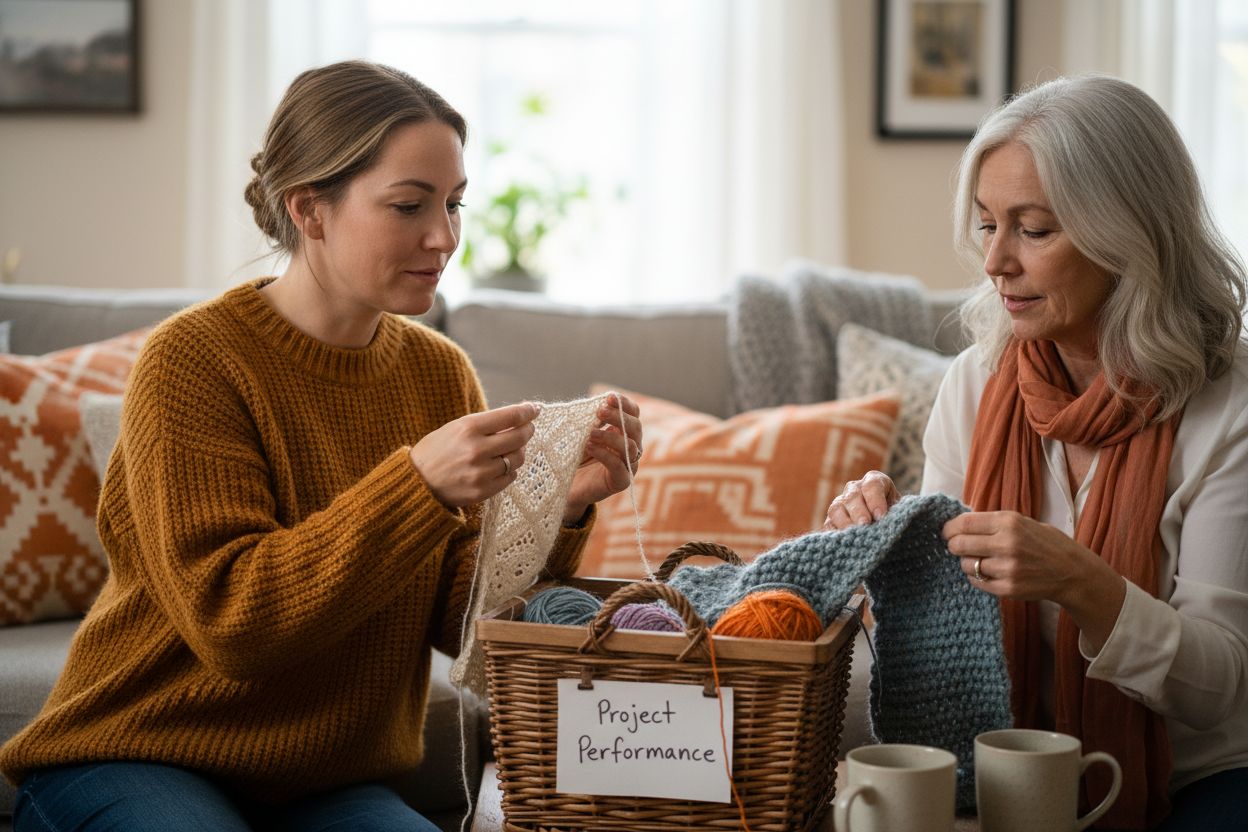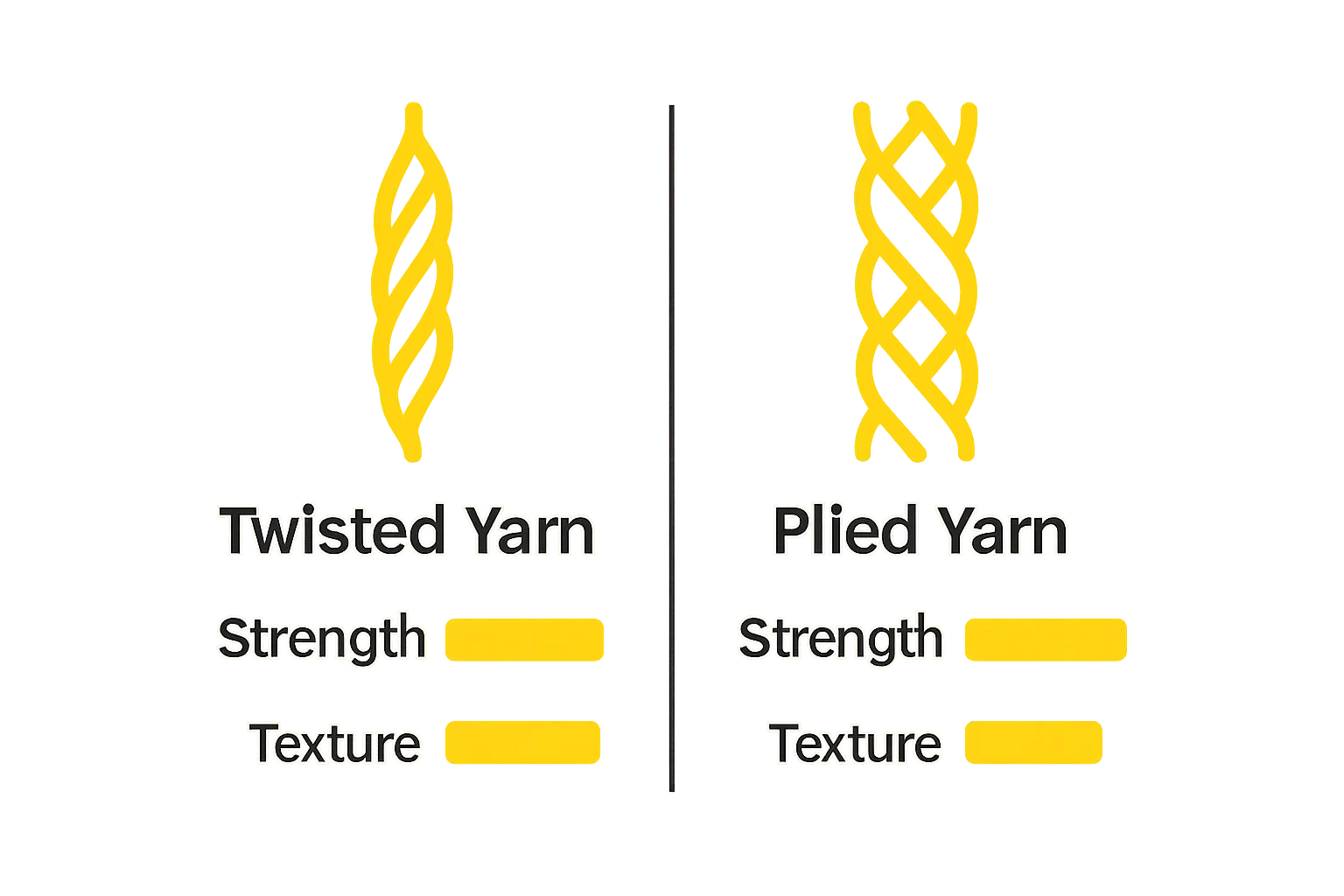
Understanding Twisted vs Plied Yarn: Key Differences
Every yarn project starts with a simple choice, and most makers do not realize how much impact it really has. One detail can change everything. A single ply of twisted yarn can make fabric feel silkier, yet plied yarn may be up to 50 percent stronger. It sounds like a minor difference, but picking the wrong yarn can mean a cozy sweater that unravels before the season ends or a delicate scarf that stands up to years of wear. The twist and ply do more than shape the yarn—they shape your entire project.
Table of Contents
- What Is Twisted Yarn And How Is It Made?
- Understanding Plied Yarn And Its Characteristics
- Why Twisted Vs Plied Yarn Matters In Your Projects
- Key Differences Between Twisted And Plied Yarn
- Practical Applications: When To Use Each Type
Quick Summary
| Takeaway | Explanation |
|---|---|
| Twisted yarn is a single strand | It’s created by mechanically twisting fibers for strength and cohesion. |
| Plied yarn consists of multiple strands | Multiple yarns are twisted together, enhancing durability and stability. |
| Choose twisted yarn for delicate projects | Ideal for lightweight items like shawls and fine lace, providing softness and drape. |
| Opt for plied yarn for heavy-duty applications | Perfect for robust textiles like winter sweaters and outdoor gear, ensuring longevity. |
| Consider project requirements when selecting yarn | Match yarn type with the desired characteristics, such as durability, texture, and complexity. |
What is Twisted Yarn and How is it Made?
Twisted yarn represents a fundamental technique in textile manufacturing where individual fibers are transformed into a continuous, stronger strand through a mechanical twisting process. Textile experts define this technique as a method of creating enhanced structural integrity by rotating fibers around a central axis.
The Science Behind Yarn Twisting
The twisting process involves systematically aligning and rotating fibers to create a unified strand with specific characteristics. When fibers are twisted together, they generate friction and cohesion, which increases the yarn’s overall strength and durability. This mechanical intervention allows different types of fibers like cotton, wool, or synthetic materials to be transformed into a more robust textile component.
Types of Yarn Twisting Techniques
There are several fundamental approaches to creating twisted yarn, each with unique properties and applications:
- S Twist: Fibers are rotated counterclockwise, creating a diagonal line slanting from left to right
- Z Twist: Fibers are rotated clockwise, creating a diagonal line slanting from right to left
- Balanced Twist: An even distribution of rotational force that creates uniform yarn structure
Each twisting method impacts the yarn’s final characteristics, including its:
- Strength and durability
- Texture and appearance
- Potential end uses in textile production
Understanding twisted yarn is crucial for crafters and textile professionals. Read more about yarn characteristics in our comprehensive yarn guide.
Understanding Plied Yarn and Its Characteristics
Plied yarn represents a sophisticated textile manufacturing technique where multiple single strands of yarn are twisted together to create a more complex and robust fiber structure. Textile manufacturing experts recognize plied yarn as a superior method for enhancing yarn performance and versatility.
The Mechanics of Plying
In the plying process, two or more individual yarn strands are systematically twisted together in the opposite direction of their original spin. This technique creates a balanced and more stable yarn with enhanced structural integrity. The countertwisting mechanism helps neutralize the individual strands’ inherent tension, resulting in a yarn that is less prone to unraveling or distortion.
Key Characteristics of Plied Yarn
Plied yarn offers several distinctive advantages that make it popular among textile crafters and manufacturers:
- Enhanced Durability: Multiple twisted strands create a stronger, more resilient yarn
- Improved Stitch Definition: The complex structure provides clearer and more precise stitch patterns
- Reduced Pilling: The tighter construction minimizes surface fiber breakage
The number of plies in a yarn can significantly impact its final characteristics.
The table below summarizes the unique features and benefits of each ply configuration commonly mentioned for plied yarn, aiding in yarn selection for specific project needs.
| Ply Count | Description | Best Use Cases |
|---|---|---|
| 2-ply | Lightweight, flexible, subtle texture | Delicate projects, light accessories |
| 3-ply | Balanced, versatile, good stitch definition | General knitting, patterned work |
| 4-ply+ | Extra robust, firm, resists heavy wear | Sweaters, rugs, outdoor or durable items |
Common configurations include:
- 2-ply yarn: Lightweight and suitable for delicate projects
- 3-ply yarn: Balanced and versatile for multiple applications
- 4-ply or more: Extremely robust and ideal for heavy-duty textiles
Learn more about selecting the right yarn for your crafting projects and understand how plied yarn can elevate your textile creations.
Why Twisted vs Plied Yarn Matters in Your Projects
Understanding the differences between twisted and plied yarn is crucial for selecting the right material for your crafting projects. Textile research indicates that yarn construction significantly impacts the final product’s performance, appearance, and durability.
Project Performance Considerations
The choice between twisted and plied yarn can dramatically influence your project’s outcome. Twisted yarn provides a more straightforward, single-strand approach suitable for lightweight and delicate projects, while plied yarn offers enhanced strength and stability for more demanding crafting applications. This fundamental difference means crafters must carefully consider their specific project requirements before selecting a yarn type.
To help clarify the core differences between twisted and plied yarn, the following table compares their structure, main characteristics, and ideal use cases.
| Attribute | Twisted Yarn | Plied Yarn |
|---|---|---|
| Structure | Single strand of twisted fibers | Multiple single yarns twisted together |
| Strength | Moderate; suitable for delicate projects | High; up to 50% stronger and more durable |
| Texture | Smoother, softer surface | More complex, often with better stitch detail |
| Durability | May unravel if overused | Superior resistance to wear and tear |
| Ideal Uses | Shawls, lace, lightweight garments | Sweaters, outdoor gear, intricate designs |
| Stitch Definition | Moderate | Excellent |
| Flexibility | More flexible for simple manipulation | Less flexible but stable for complex patterns |

Matching Yarn Construction to Project Needs
Different crafting projects demand unique yarn characteristics. Consider these key factors when choosing between twisted and plied yarn:
- Garment Durability: Plied yarn typically provides superior wear resistance
- Stitch Definition: Plied yarn often creates more precise and clear stitch patterns
- Project Complexity: Twisted yarn works well for simple designs, plied yarn for intricate work
Specific project considerations include:
- Lightweight accessories requiring soft drape
- Heavy-duty items needing maximum strength
- Delicate knitted or crocheted pieces
Learn more about selecting the right yarn for your crafting needs, ensuring your projects achieve the best possible results.
Key Differences Between Twisted and Plied Yarn
Textile manufacturing research highlights fundamental structural variations between twisted and plied yarn that dramatically impact their performance and application. Understanding these nuanced differences is crucial for crafters seeking optimal results in their textile projects.

Structural Composition
The primary distinction lies in yarn construction. Twisted yarn consists of a single strand of fibers mechanically rotated to create cohesion, while plied yarn involves multiple individual yarn strands deliberately twisted together. This fundamental structural difference determines each yarn type’s unique characteristics and potential applications.
Performance and Functional Variations
Each yarn type offers distinct advantages depending on the intended project. Crafters must consider these key performance differences:
- Strength: Plied yarn provides superior tensile strength
- Texture: Twisted yarn offers a smoother, more uniform surface
- Durability: Plied yarn demonstrates enhanced resistance to wear and tear
- Flexibility: Twisted yarn typically exhibits more straightforward manipulation
Additional comparative characteristics include:
- Twisted yarn performs better in lightweight, delicate projects
- Plied yarn excels in projects requiring complex stitch definition
- Single twisted yarns work well for simple, streamlined designs
- Multiple-ply yarns provide robust structure for intricate crafting
Explore more about selecting the perfect yarn for your crafting needs, ensuring your textile projects achieve exceptional results.
Practical Applications: When to Use Each Type
Textile manufacturing experts emphasize that selecting the appropriate yarn type is crucial for achieving optimal project results. Understanding the specific strengths of twisted and plied yarns enables crafters to make informed decisions that enhance their textile creations.
Project-Specific Yarn Selection
The choice between twisted and plied yarn depends on the specific requirements of your crafting project. Twisted yarn works best for lightweight, delicate applications, while plied yarn excels in projects demanding enhanced durability and structural complexity. Crafters must carefully evaluate their project’s technical and aesthetic needs before selecting a yarn type.
Ideal Use Cases for Different Yarn Types
Consider these specific scenarios where each yarn type demonstrates superior performance:
-
Twisted Yarn Recommended:
-
Lightweight summer garments
-
Delicate shawls and accessories
-
Fine lace knitting projects
-
Soft, draping clothing items
-
Plied Yarn Recommended:
-
Heavy winter sweaters
-
Rugged outdoor gear
-
Intricate cable knit patterns
-
High-wear functional textiles
Additional considerations for yarn selection include:
- Stitch complexity and definition requirements
- Expected garment or item longevity
- Desired texture and visual appearance
- Specific performance characteristics needed
Discover more about selecting the perfect yarn for your crafting projects, ensuring your textile creations meet both functional and aesthetic goals.
Elevate Your Next Project With the Right Yarn—Craftiss Has You Covered
Confused about whether twisted or plied yarn will make your next creation stand out? Choosing the wrong yarn can lead to loose stitches, misshaped garments, or projects that simply do not last. You want durable results and clear stitch definition, but the abundance of options can be overwhelming. Now is the perfect time to apply what you have learned to achieve beautiful, lasting results.
Browse our premium yarn collection and discover both single twisted and multi-ply options tailored to every need.
.png)
Give your projects the quality they deserve. Visit Craftiss now and select the perfect yarn for any pattern. Need to keep your collection organized as you try new techniques? Check out our yarn bags and take the next step toward your best work yet.
Frequently Asked Questions
What is the difference between twisted and plied yarn?
Twisted yarn consists of a single strand of fibers that are mechanically twisted together, while plied yarn is made by twisting multiple individual yarn strands together, which enhances its strength and durability.
When should I use twisted yarn?
Twisted yarn is ideal for lightweight and delicate projects, such as summer garments and fine lace knitting, where a smooth, single-strand texture is desired.
What are the advantages of using plied yarn?
Plied yarn offers several benefits, including enhanced durability, improved stitch definition, and reduced pilling, making it suitable for projects that require greater structural complexity and strength.
How do I choose the right yarn type for my project?
Consider the specific requirements of your project, including durability, stitch complexity, and desired texture. Twisted yarn is better for simple designs, while plied yarn excels in intricate patterns and heavy-duty textiles.


